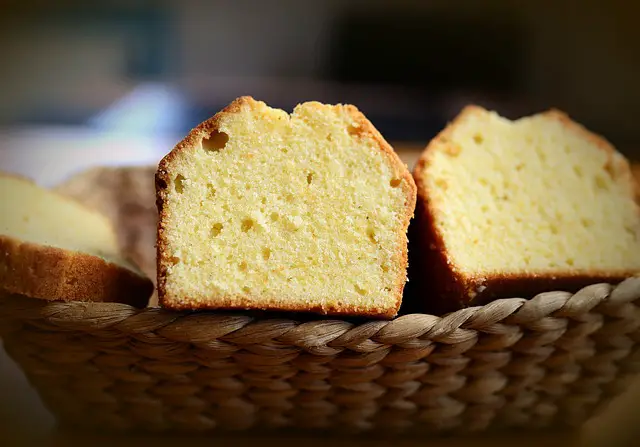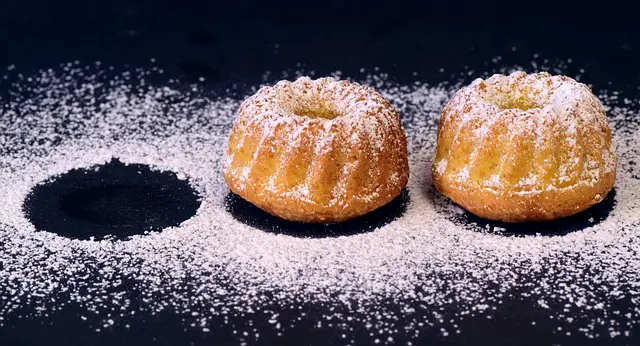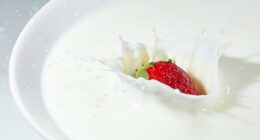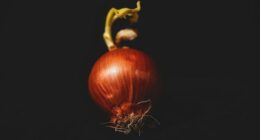Chiffon cake blends richness with airiness using oil and baking powder, while sponge cake relies solely on whipped egg whites for lightness.
Did you know that chiffon cake and sponge cake are two of the most popular cake varieties in the world? They have captured the hearts and taste buds of cake lovers everywhere with their light and airy textures. But what sets these cakes apart? In this article, we’ll delve into the key differences between chiffon cake and sponge cake, from their ingredients to their baking techniques. Whether you’re a home baker or a professional pastry chef, understanding these distinctions will help you make the perfect choice for your baking creations.
Key Takeaways:
- Chiffon cake and sponge cake are both beloved cake varieties known for their light and airy textures.
- Sponge cake is made without butter or leavening agents, relying solely on whipped egg whites for structure.
- Chiffon cake is a hybrid between a sponge cake and a butter cake, incorporating both oil and leavening agents.
- Sponge cake has a long history, dating back to the 17th century, while chiffon cake is a more recent invention, created in the 1920s.
- Baking chiffon cake requires specific techniques, such as folding dry ingredients into the whipped egg whites and using oil in the batter.
Butter Cakes vs Foam Cakes: The Two Cake Categories
When it comes to cakes, they can generally be categorized into two main types: butter cakes and foam cakes. These categories are determined by the ingredients used and the techniques employed in the baking process.
Butter Cakes
Butter cakes, as the name suggests, are cakes that contain butter or a substitute fat as one of the primary ingredients. This type of cake is known for its rich and tender texture. Butter cakes typically rely on leavening agents, such as baking powder or baking soda, to help the cake rise during baking. One popular example of a butter cake is the classic pound cake.
Foam Cakes
Foam cakes, on the other hand, do not contain fat in their ingredient list. Instead, these cakes rely on whipped egg whites to provide the structure and rise. The incorporation of air into the egg whites results in a light and airy texture. Unlike butter cakes, foam cakes do not require leavening agents like baking powder or baking soda. One well-known example of a foam cake is the sponge cake.
Let’s summarize the key differences between butter cakes and foam cakes in the table below:
| Butter Cakes | Foam Cakes |
|---|---|
| Contain butter or substitute fat | Do not contain fat |
| Use leavening agents like baking powder or baking soda | Do not require leavening agents |
| Rich and tender texture | Light and airy texture |
As you can see, the choice between butter cakes and foam cakes depends on the desired texture and taste. Butter cakes offer a richness and tenderness, while foam cakes provide a light and airy experience. Knowing these differences can help you select the perfect cake for your baking needs.
Exploring Sponge Cake

Sponge cake is a type of foam cake known for its delicate and spongy texture. Unlike butter cakes that use fat and leavening agents like baking powder or baking soda, sponge cake does not contain any butter or leavening agents. Instead, it relies on whipped egg whites for its light and airy structure.
To achieve the signature texture of sponge cake, the dry ingredients are carefully folded into the whipped egg whites. This folding technique helps to maintain the airiness, resulting in a fluffy and tender cake.
It’s important to note that while the term “sponge cake” is used to refer to this foam cake in the United States, in the United Kingdom, sponge cakes are made with additional ingredients like flour and butter.
Understanding Chiffon Cake

Chiffon cake is a unique blend of sponge cake and butter cake, offering a rich yet airy texture that’s achieved through specific ingredients and techniques. Unlike traditional sponge cakes, which rely solely on whipped egg whites, chiffon cake includes both baking powder and oil for a tender and moist crumb.
To create the fluffy texture of chiffon cake, egg whites are whipped separately until stiff peaks form. These whipped whites are then gently folded into the batter, creating air pockets that give the cake its signature lightness. Careful handling of the batter during this process is crucial to maintain the cake’s airy texture.
| Chiffon Cake | Sponge Cake |
|---|---|
| Contains baking powder and oil | Does not contain baking powder or oil |
| Rich yet light texture | Delicate and spongy texture |
| Whipped egg whites folded into the batter | Solely relies on whipped egg whites for structure |
Comparing Sponge Cake and Chiffon Cake
Sponge cake and chiffon cake may seem similar at first glance, but they have distinct differences that set them apart. While both cakes have a light and airy texture, their ingredients and preparation methods vary, resulting in variations in taste and texture.

Ingredients and Leavening Agents
Sponge cake is made without oil and relies solely on whipped egg whites for structure. It typically contains flour, sugar, eggs, and flavorings. On the other hand, chiffon cake incorporates oil and relies on a combination of whipped egg whites and baking powder for leavening. It also includes flour, sugar, eggs, and additional flavorings.
Texture and Moisture
Sponge cake has a fine, delicate crumb and a lighter, drier texture compared to chiffon cake. It tends to have a slightly dry mouthfeel but can be moistened through soaking or filling. Chiffon cake, on the other hand, has a moist and tender texture due to the presence of oil in the batter. It is often described as being more moist and rich than sponge cake.
Taste and Flavor
Due to its simpler ingredient composition, sponge cake has a subtle, neutral flavor that complements a variety of toppings and fillings. It acts as a canvas for other flavors. Chiffon cake, on the other hand, has a richer taste and a slightly denser texture than sponge cake, thanks to the inclusion of oil. It is known for its light and airy quality.
Baking Techniques
The key to making a successful sponge cake is to whip the egg whites to stiff peaks and then gently fold in the dry ingredients. This folding technique helps to prevent the loss of air and maintain the cake’s lightness. Chiffon cake, on the other hand, requires whipping the egg whites separately until stiff peaks form, folding them into the batter, and then baking the cake in a tube pan to promote even baking and rising.
In summary, sponge cake and chiffon cake may share some similarities in terms of their light and airy texture, but their differences in ingredients, leavening agents, texture, and taste make each cake unique. Understanding these distinctions will help you choose the perfect cake for your baking needs.
Angel Food Cake: Another Light and Airy Option
When it comes to light and airy cakes, angel food cake is often mentioned alongside chiffon cake. However, angel food cake has its unique qualities that set it apart from both chiffon and sponge cakes.
One distinct feature of angel food cake is its use of only egg whites, without any yolks. This results in a cake that has a stark white color and a delicate, spongy texture. Without the addition of fat or oil, angel food cake has a lightness that is unparalleled.
The key to the structure of angel food cake lies in the large amount of whipped egg whites used in the batter. The egg whites are beaten until they form stiff peaks, creating a stable and airy base for the cake.
While chiffon and sponge cakes rely on other ingredients like oil or butter for their texture and flavor, angel food cake focuses solely on the simplicity of whipped egg whites. This results in a cake that is airy, fluffy, and melts in your mouth.
If you prefer a cake that is light, delicate, and free from fats, angel food cake is an excellent choice. Its unique texture and appearance make it a standout dessert that is loved by many.
The Origins of Sponge Cake and Chiffon Cake
Sponge cake and chiffon cake have fascinating histories that span centuries. The journey of these beloved cakes highlights the evolution of baking techniques and the creativity of pastry chefs.
The History of Sponge Cake
Sponge cake has ancient origins, with recipes dating back to the 17th century. Its name derives from its light and airy texture, reminiscent of a sponge. The early sponge cake recipe consisted of basic ingredients like eggs, sugar, and flour, beaten together to incorporate air. This technique resulted in a delicate, fluffy cake that was a favorite among the elite.
The Invention of Chiffon Cake
In contrast, chiffon cake is a more modern creation, originating in the late 1920s. The credit for this innovative cake goes to an American baker named Harry Baker. Dissatisfied with the available cake options, Baker sought to create a cake that was lighter and more delicate than the popular angel food cake. Through his experiments, Baker developed a recipe that combined elements of both sponge cake and butter cake. The result was the chiffon cake, a cake that captured the best qualities of both cakes and quickly gained popularity.
Today, sponge cake and chiffon cake continue to be beloved treats enjoyed around the world. Whether you’re savoring a classic sponge cake with a cup of tea or indulging in a slice of chiffon cake topped with fresh fruit, these cakes have a rich and storied history that adds to their charm.
Tips for Baking Chiffon Cake
Baking a chiffon cake requires specific techniques to ensure a light and fluffy result. Here are some essential tips to help you achieve the perfect chiffon cake:
1. Careful Folding
When incorporating the dry ingredients into the whipped egg whites, it’s crucial to fold gently and carefully. This technique helps maintain the airiness of the batter, resulting in a light and delicate cake texture.
2. Use Oil in the Recipe
Chiffon cake recipes often call for oil, which helps make the batter easier to beat air into. The oil adds moisture and richness to the cake while contributing to its light and airy structure.
3. Whipping Egg Whites
Whipping the egg whites separately and to the correct stiffness is essential for a successful chiffon cake. The whipped egg whites provide the desired lift and fluffiness to the cake. Make sure to beat the egg whites until stiff peaks form.
4. Cooling the Cake
After removing the chiffon cake from the oven, it’s important to cool it upside down to prevent a collapse. This technique helps maintain the cake’s height and structure as it cools.
5. Using the Right Pan
A tube pan or an angel food cake pan is ideal for baking chiffon cakes. These pans have a center tube that promotes even heat distribution and allows the cake to rise and bake evenly.
Follow these tips and techniques to create a chiffon cake that impresses with its lightness and heavenly texture. Enjoy experimenting with flavors and variations to make your chiffon cakes truly unique!
Experimenting with Chiffon Cake Flavors
Chiffon cake is a versatile cake that can be customized with various flavors and toppings. Adding different flavors to the basic chiffon cake recipe can elevate its taste and make it even more delightful. Here are some popular chiffon cake flavor variations:
- Lemon Chiffon Cake: Refreshing and zesty, lemon chiffon cake is a perfect choice for citrus lovers. The tangy lemon flavor adds a vibrant twist to the light and fluffy chiffon cake.
- Chocolate Chiffon Cake: Indulge your chocolate cravings with a decadent chocolate chiffon cake. The rich cocoa flavor pairs perfectly with the airy texture of the chiffon cake, creating a luscious treat.
- Coconut Chiffon Cake: Transport yourself to a tropical paradise with a coconut chiffon cake. The subtle coconut flavor adds a delightful hint of sweetness, making it a perfect cake for summer gatherings.
- Strawberry Chiffon Cake: Bursting with the sweetness of fresh strawberries, this variation of chiffon cake is perfect for strawberry season. The natural sweetness of the strawberries complements the light and airy chiffon cake.
These are just a few examples of chiffon cake flavors you can experiment with. Don’t be afraid to get creative and try out different flavors that pique your interest. You can also combine flavors or add additional toppings to make your chiffon cake truly unique.
| Chiffon Cake Flavor | Taste Profile | Recommended Toppings |
|---|---|---|
| Lemon | Zesty and refreshing | Whipped cream, lemon glaze |
| Chocolate | Rich and indulgent | Chocolate ganache, chocolate shavings |
| Coconut | Tropical and sweet | Toasted coconut flakes, pineapple salsa |
| Strawberry | Sweet and fruity | Fresh strawberries, strawberry compote |
Conclusion
When it comes to chiffon cake versus sponge cake, there are clear differences in terms of ingredients, texture, and techniques. Chiffon cake combines the richness of a butter cake with the lightness of a sponge cake, resulting in a unique and delightful flavor. On the other hand, sponge cake relies solely on whipped egg whites for its structure, creating a light and airy texture that is perfect for delicate desserts.
Understanding these differences is essential for making informed choices in your baking endeavors. Whether you prefer the richness of chiffon cake or the lightness of sponge cake, knowing the distinctions between the two can help you select the right cake for your desired outcome. So, the next time you’re deciding on a cake for a special occasion or simply to indulge in a homemade treat, keep in mind the variations between chiffon and sponge cake, and choose the one that suits your preferences best.
FAQ
What’s the difference between chiffon cake and sponge cake?
Chiffon cake is a hybrid between a sponge cake and a butter cake, containing both baking powder and oil. Sponge cake, on the other hand, is made without oil and relies solely on whipped egg whites for structure.
What are the main differences in texture between chiffon cake and sponge cake?
While both chiffon cake and sponge cake have a light and airy texture, chiffon cake tends to be richer and more moist due to the addition of oil, while sponge cake is lighter and drier.
How do the ingredients differ between chiffon cake and sponge cake?
Chiffon cake incorporates both baking powder and oil in its recipe, while sponge cake does not contain any oil or leavening agents like baking powder.
Can I use the same recipe to make both chiffon cake and sponge cake?
No, you cannot use the same recipe to make both chiffon cake and sponge cake. Chiffon cake requires the addition of oil and specific techniques for folding in the ingredients, while sponge cake relies solely on whipped egg whites for its structure.
How do I achieve a light and fluffy chiffon cake?
To achieve a light and fluffy chiffon cake, it is important to carefully fold the dry ingredients into the whipped egg whites, maintaining the airiness. The addition of oil in the chiffon cake recipe also helps to create a fluffy texture.
What is the difference between chiffon cake and angel food cake?
While both chiffon cake and angel food cake have a light and airy texture, chiffon cake contains oil and relies on whipped egg whites and baking powder for structure, whereas angel food cake uses only egg whites and no yolks, resulting in a more delicate texture.
What flavors can I add to chiffon cake?
Chiffon cake is a versatile cake that can be customized with various flavors such as lemon, chocolate, coconut, and strawberry. These additions can enhance the taste and add unique flavors to your chiffon cake.
How old is the tradition of making sponge cake?
Who invented chiffon cake?
Chiffon cake was invented in the late 1920s by an American baker named Harry Baker, who aimed to create a cake lighter and more delicate than angel food cake.
Can I use a chiffon cake recipe to make sponge cake?
No, you cannot use a chiffon cake recipe to make sponge cake as they have different ingredient ratios and techniques. Sponge cake relies solely on whipped egg whites for its structure and does not contain oil or leavening agents like baking powder.
Source Links
- https://www.tastingtable.com/824969/whats-the-difference-between-sponge-cake-and-chiffon-cake/
- https://www.southernliving.com/food/desserts/cakes/chiffon-cake-vs-sponge-cake
- https://www.allrecipes.com/what-is-chiffon-cake-7368398
Image Credits
Featured Image By – Graciela Moreno from Pixabay
Image 1 By – Kanko from Nagasaki, Japan, CC BY 2.0, via Wikimedia Commons
Image 2 By – congerdesign from Pixabay









